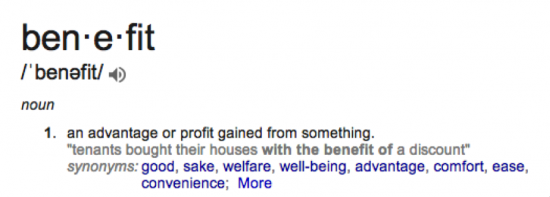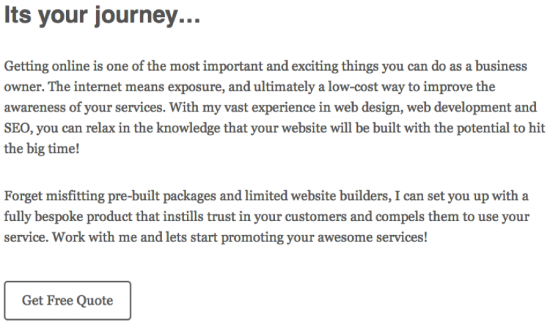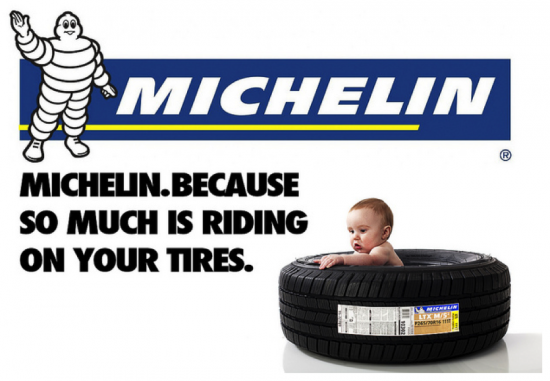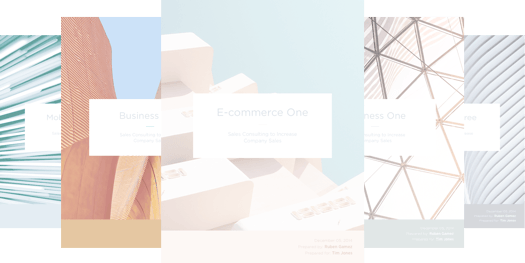
The conversation turns to what exactly will you do to solve their problem.
You’re good – you already have a sales pitch for this.
You start talking about search engine optimization (SEO), keywords, usability, and all the other “buzz words” commonly used in your industry.
The problem?
Well, for starters, your client likely doesn’t know much about your industry – that’s why they want to hire you. Plus, your explanations are just confusing (and probably frustrating) them more …
Another problem is they’re likely thinking, “So what?!”
Which is ironically the exact same thing you should ask yourself to successfully sell your services …
You’re Selling Features, They Want to Buy Benefits
Your potential client is thinking, “So what?!” because they don’t care about industry buzz words. To them, those words are “features” of your service.
Your potential client cares about one thing:
“What’s in it for me?”
They want to know about (and understand) the “benefits” of your service.
“Prospects don’t want features. They want you to change their lives for the better.” – Clayton Makepeace
Here’s the difference:
Features are the facts about your product or service. Your features might be “7-day turnaround” or “search engine optimized.”
These features are great, but they fail to effectively sell your services because they don’t really answer your client’s main question: “What’s in it for me?” … at least in a way that your potential client can immediately relate to and desire.
That’s why you need to turn your features into benefits.
Benefits explain the value behind the features. They are the way you change your client’s life … Benefits are the real reason a client will hire you.
For instance, a benefit associated with “7-day turnaround” might be, “You’ll get your project finished earlier, so you can implement it faster, and start profiting sooner!” (Time is money, after all.)
A benefit for “search engine optimized,” might be, “Your ideal customers will find you more often and when they’re perfectly positioned to spend money.”
How to Go from Features to Benefits
The easiest way to turn your features into benefits is to ask yourself, “So what?!”
First, make a list of all the features of your service … Features essentially tell you the what.
If you’re a web designer, here are a few things that may be on your list:
- Projects guaranteed to be completed by the deadline.
- Built on WordPress.
- Editable EPS files provided.
Here’s an example I found when searching for “freelance web designer” on Google:
As you see he lists his features – many of which are great if you know what you’re looking for …
However, his potential clients might not have a clue about how his “skills” will benefit them …
That’s why it pays off to include the benefits … so – if your potential clients are asking, “So what?!” – you’re already answering and increasing the chances that they’ll hire you …
What are Benefits?
A benefit is defined as:
A benefit is not the what, it’s the why. It answers your potential client’s biggest question, “What’s in it for me?”
To find your benefits, first grab your list of features made earlier. Then, look at the first one …
Let’s say it is, “Projects guaranteed to be completed by the deadline.”
Now, put yourself in your ideal client’s shoes …
Ask yourself, “So what?”
Or, “Why does that matter that they’re guaranteed to get their project completed by the deadline?”
The answer will vary depending on your ideal client, but a few options might be:
- They won’t have to stress about answering to their boss when it’s not done.
- They can relax knowing the project will be done on time.
- They don’t have to constantly follow up during the process.
See how that works?
Truth is, you likely already knew what your client really wanted when you added that feature to your list. But, by taking the time to actually spell the benefits out for them, you’ll be able to sell your services more successfully.
Let’s do one more example:
- Built on WordPress.
Remember to think like your ideal client when asking yourself, “So what?”
Or, “Why does it matter that their site will be built on WordPress?”
Again, the answer will vary depending on your ideal client, but a few answers might be:
- With WordPress they can update their website as easily as sending an email. So? No more bottlenecks while waiting on someone to make simple changes – like adding something to their online menu.
- They can interact with their customers – and sell more – by moderating their own comments – from the phone app. So? They can make sales even when they’re away from the computer!
- WordPress is free … So what? Well, they can spend their money on plugins for functionality, more advertising, or to take their team out for a celebratory beer once the site launches!
Aren’t those benefits more appealing – and more likely to sell your services – than listing “Built on WordPress” as a feature?
Here’s an example from another freelance web designer’s website:
Notice how he explained some of the benefits of working with him?
- More exposure
- Instills trust
- His experience means you can relax …
But, let’s brainstorm some ways he could answer the question his ideal clients are likely thinking …
More exposure … so what?
You’ll reach more potential customers, which means more sales, a better business, and more money!
Instills trust … so what?
Visitors to your website will be more likely to hire you – meaning you’ll have better conversions and need to market less.
Also, you won’t have to work so hard to sell your services because your new website will do it for you!
Your turn …
What benefits can you come up with for, “His experience means you can relax” … ?
Now that you understand how to find your benefits, go through your entire features list, asking, “So what?” and turning your features into benefits.
To help you, here’s another example where the web designer outlined some of their benefits:
Notice how they listed the feature and then explained why it matters below?
Website and application design … so what?
He’ll help you figure out the best way to achieve your website goals … so your site will “deliver more customers.”
Front-end web development … so what?
His methods and experience mean your site will look good today AND be “future proofed” … so you don’t have to turn around and have it redone in a few months!
While this example is definitely better and more focused on the benefits of his services, he could still dig in deeper to appeal to his potential clients more …
That’s where the “deeper benefit” comes in …
What is the Deeper Benefit?
The deeper benefit goes another step (or several steps) further in answering the question, “So what?”
The deeper benefit really gets to the root of your ideal client’s problem … and your promise to help them …
So, how can we find the deeper benefit?
Well, it’s like digging a hole. If you want the hole to be deeper, you keep digging …
Let’s go back to your list of features and benefits …
Be sure you’re ready to think like your ideal client and – again – ask yourself, “So what?”
But this time, don’t stop. Keep asking, “So what?” until the benefit is so obvious that you simply can’t ask, “So what?” …
Here’s an example from Michelin:
In this ad, Michelin is basically saying, “You can depend on our tires to safely transport your family.”
But, how do you think they arrived at that “deeper benefit?”
Well, let’s go through an example conversation that may have happened when their marketing department was planning this campaign …
First, they put their “ideal client” hat on … for this ad, it was likely “parents.” But, it could have easily been more specific, such as, “new mothers who purchased new tires – or a new vehicle – more than two years ago and have a combined household income of over $50,000 per year.”
Then – just like you did earlier – they start with a list of their features. Here’s an example feature they might list:
The Michelin tire can remove over 2 gallons of water per second from under and between it’s treads.
Then, they ask the question their ideal client will likely be thinking … “So what?!”
It will help to keep your car from hydroplaning when the road is wet.
“So what?”
You can more easily keep control of your vehicle and reduce the chance of crashing …
Now, at this point, many marketers would stop digging …
It’s pretty obvious that no one wants to crash …
But, if you really want to appeal to your buyer, ask, “So what?” again and dig just a bit deeper …
“With Michelin tires you’ll be able to relax knowing you’ve done everything in your power to protect your greatest joy – your baby in the backseat.”
Michelin tires aren’t just promising good tires and safety features.
They’re promising peace of mind!
That’s a deeper benefit.
Look at your list again …
Have you found the deeper benefits? Or do you still have some digging to do?
If you’re not sure – or you’d like some help, please comment below. Tell us the feature you want to turn into a benefit and let’s get to digging …






